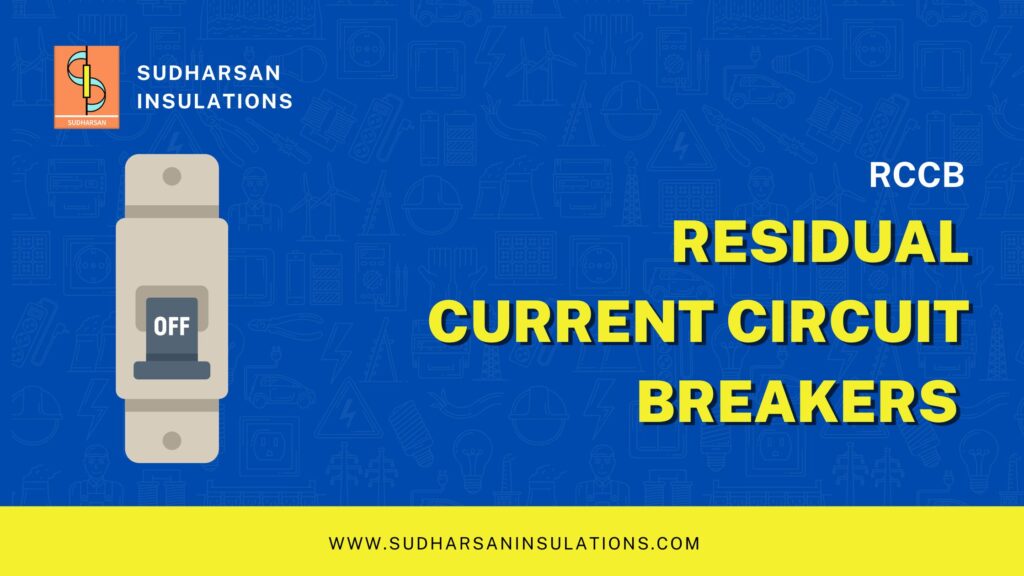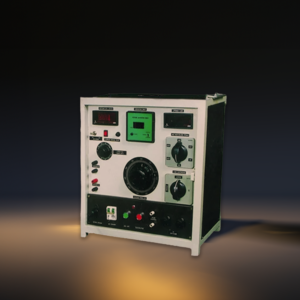Residual Current Circuit Breakers (RCCB)
Last Updated : May 29, 2024

What is a Residual Current Circuit Breaker (RCCB)?
A Residual Current Circuit Breaker (RCCB), also known as a Residual Current Device (RCD) or an Earth Leakage Circuit Breaker (ELCB), is an essential electrical safety device designed to protect against electric shocks and fire hazards caused by earth leakage currents. These currents can occur due to insulation faults, damaged cables, or electrical equipment malfunctions.
The primary function of an RCCB is to continuously monitor the electrical circuit for any imbalance between the live and neutral conductors. If a leakage current exceeds a predetermined value, typically between 10mA and 300mA, the RCCB automatically trips, cutting off the power supply to the circuit, thereby preventing potential hazards.
It’s important to note that RCCB are also referred to by various other names, such as:
- Residual Current Breaker with Overcurrent Protection (RCBO)
- Residual Current Circuit Breaker with Integral Overcurrent Protection (RCBO)
- Residual Current Circuit Dispositif (RCCD)
These terms may vary depending on the region or specific application, but they all refer to the same safety device designed to protect against earth leakage currents.
How Do RCCB Work?
RCCB operate based on the principle of current transformation and electromagnetic induction. The device consists of two toroidal transformers, one for the live conductor and one for the neutral conductor. Under normal conditions, the currents flowing through these transformers are equal and opposite, resulting in a net magnetic field of zero.
However, if a leakage current occurs due to an insulation fault or a person coming into contact with a live conductor, the currents in the live and neutral conductors become imbalanced. This imbalance creates a residual magnetic field, which induces a current in the RCCB’s secondary winding. If this induced current exceeds the RCCB’s predetermined tripping threshold, typically between 10mA and 300mA, the RCCB’s tripping mechanism is activated, and the circuit is disconnected.
The tripping mechanism in RCCB can vary but typically involves an electromagnet or a solenoid that releases a spring-loaded mechanism, causing the contacts to separate and break the circuit.
Types of RCCB
RCCB can be classified into several types based on their operating principles and applications:
- AC RCCB: These are designed to detect leakage currents in alternating current (AC) circuits and are commonly used in residential and commercial installations.
- Pulsating DC RCCB: These RCCB can detect leakage currents in circuits with pulsating direct current (DC), such as those found in certain industrial applications or power supplies for electronic equipment.
- Pure DC RCCB: Designed specifically for pure direct current (DC) circuits, these RCCB are commonly used in photovoltaic (PV) systems, telecommunications equipment, and other DC applications.
- Selective RCCB: Also known as time-delayed RCCB, these devices incorporate a delay mechanism that allows them to discriminate between leakage currents caused by transient disturbances and those caused by persistent faults. This feature helps prevent nuisance tripping in environments with high electromagnetic interference (EMI) or large capacitive loads.
Applications of RCCB
RCCB are widely used in various applications to ensure electrical safety and comply with relevant regulations and standards. Some common applications include:
Residential Installations
In residential settings, RCCB are mandatory in many countries to protect against electric shocks and fire hazards caused by leakage currents. They are typically installed at the main distribution board or at individual circuit levels, depending on local regulations.
Commercial and Industrial Facilities
RCCB are essential in commercial and industrial environments, where the risk of electrical hazards is higher due to the presence of heavy machinery, power tools, and other electrical equipment. They help protect personnel and prevent costly damages caused by electrical faults.
Outdoor and Harsh Environments
RCCB designed for outdoor and harsh environments, such as construction sites, mines, or marine applications, are built to withstand challenging conditions like moisture, dust, and extreme temperatures.
Specific Applications
Certain applications may require specialized RCCB, such as:
- Swimming pools and spas: RCCB with higher sensitivity (≤30mA) are mandatory to protect against electric shocks in wet environments.
- Construction sites: Portable RCCB with built-in sockets are commonly used to provide temporary power distribution with added safety features.
- Medical facilities: RCCB with high immunity to electromagnetic interference (EMI) are essential for protecting sensitive medical equipment.
Choosing the Right RCCB
Selecting the appropriate RCCB for a particular application is crucial to ensure proper protection and compliance with relevant standards and regulations. Here are some key factors to consider:
Rated Current and Voltage
RCCB are available in various rated current and voltage ratings to match the requirements of the electrical circuit they are intended to protect. It’s essential to choose an RCCB with a rated current and voltage that meets or exceeds the circuit’s specifications.
Tripping Current Sensitivity
The tripping current sensitivity of an RCCB determines the maximum leakage current at which it will trip. Common sensitivity levels are 10mA, 30mA, 100mA, and 300mA. Higher sensitivity levels (e.g., ≤30mA) are typically required for applications with increased risk of electric shock, such as swimming pools or construction sites.
Type of RCCB Based on Application
As discussed earlier, different types of RCCB are designed for specific applications, such as AC, pulsating DC, or pure DC circuits. Selecting the correct type of RCCB based on the application is crucial for ensuring proper protection.
Considerations for Special Environments
In harsh or hazardous environments, such as those with high levels of electromagnetic interference (EMI) or extreme temperatures, specialized RCCB may be required. These RCCB are designed to withstand such conditions and provide reliable protection.
Installation and Testing of RCCB
Proper installation and regular testing of RCCB are essential for ensuring their effective operation and maintaining electrical safety.
Wiring Requirements
RCCB must be installed in accordance with the manufacturer’s instructions and relevant electrical codes and standards. Factors such as conductor sizing, proper grounding, and circuit layout should be carefully considered during installation.
Proper Installation Procedures
Installing an RCCB involves connecting the live and neutral conductors through the device’s toroidal transformers and ensuring proper wiring and terminations. It’s crucial to follow the manufacturer’s guidelines and local regulations for a safe and compliant installation.
Importance of Regular Testing
Regular testing of RCCB is mandatory in many regions to ensure they are functioning correctly. Testing should be performed at regular intervals, typically every 6 to 12 months, or as specified by local regulations or the manufacturer’s recommendations.
Test Procedures and Equipment
Testing an RCCB involves simulating a leakage current condition and verifying that the device trips within the specified time frame. This can be done using specialized RCCB testing equipment or by following the manufacturer’s recommended test procedures. It’s essential to follow proper safety precautions during testing.
Maintenance and Troubleshooting
Like any electrical device, RCCB require periodic maintenance and may encounter issues that require troubleshooting.
Common Issues and Cause
Some common issues that may arise with RCCB include:
- Nuisance tripping: Caused by factors such as high electromagnetic interference (EMI), large capacitive loads, or transient currents.
- Failure to trip: This can be due to aging components, internal faults, or incorrect installation.
- False tripping: Caused by external factors like voltage surges or electromagnetic disturbances.
Maintenance Best Practices
To ensure the reliability and longevity of RCCB, it’s recommended to follow these maintenance best practices:
Sure, let’s continue with the comprehensive blog post on Residual Current Circuit Breakers (RCCB).
Troubleshooting Techniques
- Visual inspection: Thoroughly inspect the RCCB and associated wiring for any signs of damage, loose connections, or other visible issues.
- Isolation and testing: Isolate the RCCB from the circuit and perform functional tests using appropriate testing equipment to identify if the issue lies with the RCCB or elsewhere in the circuit.
- Eliminate potential interference sources: Identify and eliminate potential sources of electromagnetic interference (EMI) or transient currents that may be causing nuisance tripping or false tripping.
- Check for grounding issues: Ensure that the RCCB and the associated circuit are properly grounded, as improper grounding can lead to operational issues.
- Consult manufacturer guidelines: Refer to the manufacturer’s troubleshooting guidelines and technical support resources for specific advice on resolving issues with their products.
- Seek professional assistance: If the issue persists, seeking assistance from a qualified electrical professional may be necessary to diagnose and resolve complex or persistent problems with RCCB.
Replacement Guidelines
RCCB have a limited lifespan and should be replaced periodically, even if they appear to be functioning correctly. The recommended replacement interval typically ranges from 10 to 25 years, depending on the manufacturer’s guidelines and the operating conditions.
It’s essential to replace an RCCB if it fails to trip during regular testing or if it shows visible signs of damage or degradation. Attempting to repair or modify an RCCB is generally not recommended, as it may compromise its safety and functionality.
RCCB Standards and Regulations
RCCB are subject to various national and international standards and regulations to ensure their safety, performance, and compliance with electrical codes.
Relevant Standards
Some of the major standards governing RCCB include:
- IEC 61008 and IEC 61009: International standards published by the International Electrotechnical Commission (IEC) that specify the general requirements and test methods for RCCB.
- IEC 62423: A complementary IEC standard that covers the specific requirements and test methods for RCCB used in photovoltaic (PV) systems.
- NFPA 70 (National Electrical Code, NEC): The NEC, published by the National Fire Protection Association (NFPA), provides guidelines and requirements for the installation of RCCB in the United States.
- AS/NZS 3000: The Australian/New Zealand Wiring Rules, which outline the requirements for RCCB installation and testing in those regions.
Regional and Local Regulations
In addition to international standards, various regions and localities may have their own specific regulations and guidelines for the installation, testing, and maintenance of RCCB. It’s crucial to consult and comply with these local regulations to ensure electrical safety and compliance.
Compliance Requirements
Manufacturers of RCCB are required to design, test, and certify their products in accordance with the relevant standards and regulations. Additionally, electrical contractors, installers, and end-users must ensure that RCCB are installed, tested, and maintained according to the applicable standards and local regulations.
Failure to comply with RCCB standards and regulations can result in legal consequences, as well as potential safety hazards and liabilities in the event of an electrical incident.
RCCB Safety Tips
While RCCB are designed to enhance electrical safety, it’s essential to follow proper handling and usage guidelines to ensure their effective operation and to minimize potential risks.
Handling Precautions
- When handling RCCB, observe the following precautions:
- Ensure that the RCCB is de-energized and disconnected from the electrical circuit before performing any installation, maintenance, or testing activities.
- Follow the manufacturer's instructions carefully for proper installation, testing, and maintenance procedures.
- Use appropriate personal protective equipment (PPE), such as insulated gloves and safety glasses, when working with RCCB.
Proper Usage Guidelines
- To ensure the safe and efficient operation of RCCB, follow these usage guidelines:
- Never bypass or disable an RCCB, as this compromises electrical safety and violates regulations.
- Regularly test RCCB according to the manufacturer's recommendations and local regulations.
- Replace RCCB promptly if they fail to trip during testing or show signs of damage or malfunction.
- Consult qualified electrical professionals if you encounter any issues or have concerns regarding the operation of RCCB.
Educating Users on RCCB Importance
It’s crucial to educate users, such as homeowners, facility managers, and employees, about the importance of RCCB and their role in electrical safety. Provide clear instructions on how to test RCCB, recognize potential issues, and respond appropriately in case of an RCCB trip or malfunction.
Regular safety training and awareness campaigns can help reinforce the significance of RCCB and promote a culture of electrical safety in residential, commercial, and industrial settings.
Conclusion
Residual Current Circuit Breakers (RCCB) play a vital role in ensuring electrical safety by protecting against earth leakage currents and the associated risks of electric shocks and fire hazards. Understanding the principles, types, applications, and proper installation and maintenance of RCCB is crucial for ensuring their effective operation and compliance with relevant standards and regulations.
As technology continues to evolve, advancements in RCCB design, materials, and features can be expected to further enhance their performance, reliability, and suitability for various applications. Additionally, increased awareness and education on the importance of RCCB will contribute to a safer electrical environment for residential, commercial, and industrial settings.
By following best practices, conducting regular testing and maintenance, and staying up-to-date with the latest standards and regulations, stakeholders can ensure the continued effectiveness of RCCB in mitigating electrical hazards and promoting a safer electrical infrastructure.
Other Products from Sudharsan Insulation are
ELCB, High Voltage Kits, Loading Transformers, Primary Current Injection Test Kit, Secondary Injection Kits, MCCB Kits




